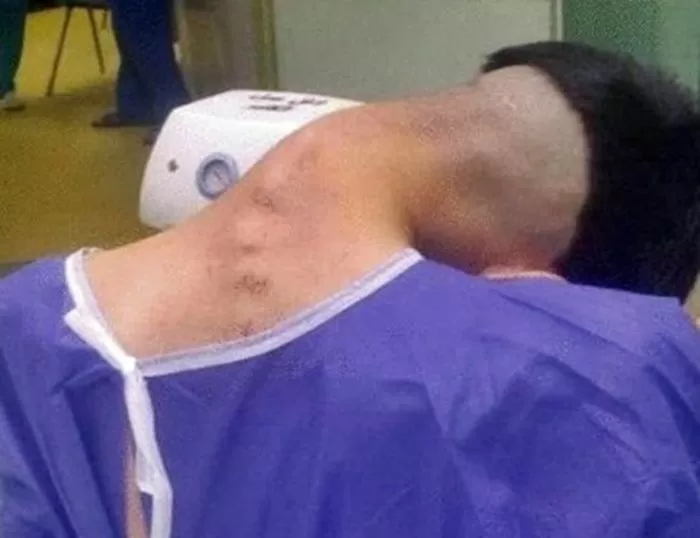Doctors at Iran’s Isfahan University of Medicine recently documented the case of a 23-year-old male whose head dropped to a 90-degree angle because his neck muscles could no longer support it.
Cervical Kyphospholiosis (CKS), aka “Dropped Head Syndrome,” is a serious medical condition characterized by weakness in the neck extensor muscles, which renders them unable to support the weight of the head. It is usually associated with various neuromuscular conditions, including mitochondrial myopathy, congenital myopathy, motor neuron disease, or anatomical abnormalities. such as an unusually large head, but doctors at an Iranian university recently reported a previously undocumented case of CKS caused by years of substance abuse.

Photo: Iran’s Isfahan Medical University
The 23-year-old unnamed patient was described as “hailing from a socioeconomically disadvantaged background,” with “a significant medical history of major depressive disorder and substance abuse, including addiction to heroin, opium, and amphetamines.” Doctors at the Isfahan University of Medicine wrote that “after every episode of amphetamine use, the patient consistently maintained a fixed kyphotic neck position for extended periods, leading to a progressive alteration in his cervical alignment.”
Cranial nerve testing yielded normal results, as did muscle strength and autonomic function tests, but a CT scan revealed a severe kyphoscoliosis deformity affecting the patient’s C3, C4, and C5 vertebrae. After assessing the severity of his condition, doctors opted for a three-stage surgical solution to remove the deformed bone and realign his neck in a proper position. Luckily, the operation was a success, and the patient was able to walk with a special collar a day later and was discharged after three days.
Doctors reported that the 23-year-old patient had tried various traditional and herbal remedies, but none had alleviated his symptoms, so he eventually sought medical attention. Following the surgery, he had several psychiatric consultations, and he was able to give up drugs. A 1‐year follow‐up revealed satisfactory improvement in alignment and correction in the position of the cervical spine.

Photo: Unsplash
“We discovered that drug abuse contributed to the uncommon development of severe complicated cervical kyphosis,” the Iranian doctors wrote in their case report. “The drug does not have a direct effect on musculoskeletal changes. Instead, there is an indirect effect: When the patient uses the drug, they remain in a certain position for a long time, and over months, this results in musculoskeletal changes that lead to kyphoscoliosis.”
The previously undocumented connection between severe substance abuse and dropped head syndrome has been given the name “intoxicated syndrome”.


0 Comments